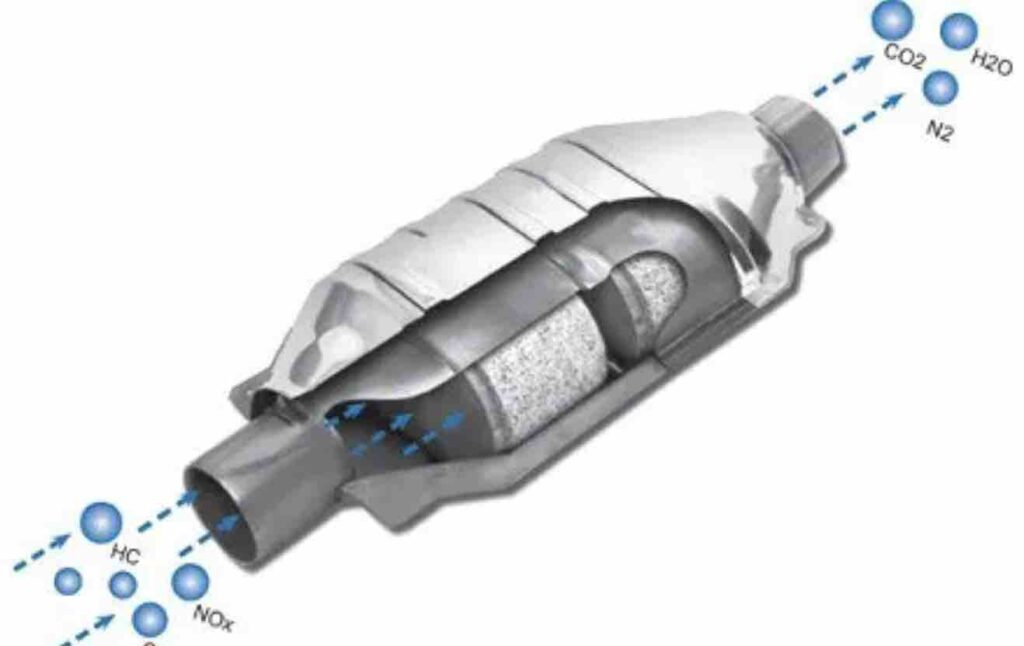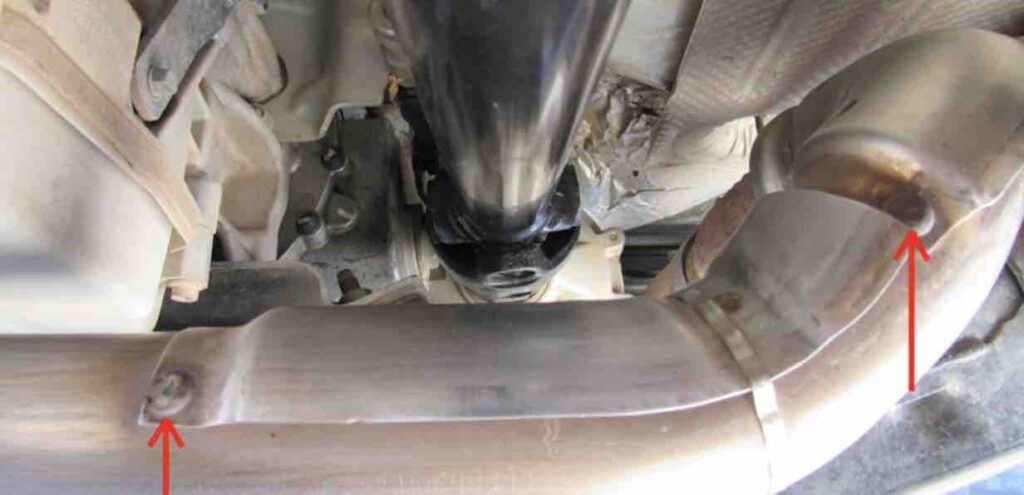Catalytic converters have been around for decades. They help reduce emissions by converting harmful exhaust gases into less harmful ones, such as carbon dioxide and water vapor.
The amount of emission reduction that a catalytic converter provides depends on several factors, including the type of car it is installed on, driving habits (such as how often you drive), engine size/type, fuel quality, and the age and condition of the vehicle’s components.

How does a catalytic converter reduce pollution?
The process begins when toxic emissions enter the catalyst chamber, where they react with oxygen molecules over its surface, which have been coated with various materials such as platinum or palladium.
These materials cause oxidation reactions that convert dangerous gases like nitrogen oxide (NOx) into harmless forms like nitrous oxide (N2O).
In addition to reducing NOx levels in exhaust fumes from cars equipped with modern emission control systems, it also reduces levels of unburned hydrocarbons (HC), another pollutant found in vehicle exhausts due to incomplete combustion processes within engines.
In this reaction, oxygen molecules react with hydrocarbons present in fuel combustion products, which then produce carbon dioxide (CO2) instead of more hazardous compounds like nitrous oxide (NOx).
How Much Does A Catalytic Converter Reduce Emissions
So, just how much of a difference do catalytic converters contribute to reducing emissions? Well, my direct answer is a pretty significant amount! On average, catalytic converters are capable of reducing the emissions of harmful carbon monoxide and other unhealthy gases by up to 90%. Going by this amount, we can conclude that the amount of harmful substances released into the air is significantly reduced, positively impacting air quality and the environment. You must also note that catalytic converters don't completely eliminate emissions. However, the 90% reduction in emissions catalytic converters contributes is a big step in the right direction and helps us work towards a cleaner, healthier future.
Related article:
- The Cheapest Way to Fix Catalytic Converter, Cost & How to Fix
- What Is Cat Delete ‘s Pros And Cons, Is It Illegal? (Pipe & Kit)
Do you burn more fuel without a catalytic converter?
From personal experience, the answer is yes. A catalytic converter stabilizes fuel consumption. So, without it, your vehicle will consume more fuel. This is due to several factors, such as increased exhaust backpressure and reduced air-fuel ratios, that occur when these devices are absent from an engine system.
Moreover, combustion efficiency suffers since unburned hydrocarbons can escape through the tailpipe instead of being burned off by the catalyst inside a working catalytic converter unit.
Does a catalytic converter reduce gas mileage?
The answer depends on several factors, such as driving habits and vehicle maintenance levels. But generally, having a properly functioning catalytic converter installed will help increase your vehicle’s fuel efficiency as it reduces emissions from your car’s tailpipe.
Do catalytic converters reduce global warming?
Catalytic converters can play a role in reducing global warming. They contribute to lowering the number of harmful pollutants released into the atmosphere by converting them into less hazardous substances.
These pollutants contribute greatly to smog formation and can have serious health consequences for humans exposed over long periods, such as the increased risk for respiratory illnesses like asthma or COPD (Chronic obstructive pulmonary disease).
Also, CO2 is one of the primary contributors to climate change; when it’s emitted from car engines, it traps heat near the Earth’s surface, instead of allowing it to escape out into space; this occurrence is known as “the greenhouse effect.”
Catalytic converters help keep these dangerous gases out of our atmosphere while still providing us with transportation options that don’t rely on fossil fuels alone, making them an essential tool in fighting against global warming.
Can I run my vehicle without a catalytic converter?
Yes, you can, but some exceptions may apply depending on your location and circumstances.
It may be “illegal” in specific countries to operate a vehicle without a catalytic converter installed, and doing so, can result in hefty fines or other legal penalties.
However, in some cases where vehicles do not meet certain emission standards or have been modified from their original design specifications—such as race cars, it may be possible to obtain an exemption allowing you to run a vehicle without a catalytic converter.
Running your car without a catalytic converter should be shunned due to the potential consequences associated with breaking environmental laws. Without one, your car would not be able to pass emissions tests.
What happens if I remove the catalytic converter?
Removing this part may cause other issues with engine performance due to increased exhaust back pressure or incorrect fuel-air ratios, which could lead to expensive repairs.
In some countries, like Australia and the USA, tampering with emission control systems is illegal and carries heavy fines. Furthermore, insurance companies may refuse coverage for any damage caused by modifications, so it’s best not to remove the catalytic converter in your vehicle.
Are catalytic converters good for the environment?
In clear terms, catalytic converters are good for the environment. They work by converting harmful gases such as carbon monoxide, hydrocarbons, and nitrogen oxides into less harmful substances like water vapor, nitrogen gas, and carbon dioxide. This helps improve air quality by reducing smog-causing emissions from vehicle exhausts.
What is the major downside of the catalytic converter?
Catalytic converters can be quite expensive to replace or repair when they become damaged or clogged from prolonged use. This makes them a financial burden for car owners who need to replace their existing converter inorder to maintain proper emissions standards and keep their cars running smoothly.
Another issue related to catalytic converters is that they can often fail prematurely due to poor maintenance practices, such as neglecting regular oil changes and other necessary services like spark plug replacements.
When these components are not properly taken care of, it can cause buildup inside the converter, which will eventually lead to its failure before its expected lifespan has been reached, ultimately resulting in higher costs for replacement parts and labor fees.
Also among the downsides of the catalytic converter is that, some vehicles may have difficulty passing smog tests if their catalytic converters have failed due to excessive buildup.
This could mean costly repairs if you live in an area where smog testing laws are strictly enforced by local authorities or state governments.
Even though most modern cars come equipped with a factory-installed version, these devices still require regular maintenance, just like any other part under your hood. So make sure you stay up-to-date with all recommended service intervals from your manufacturer’s manual.
Conclusion
The amount at which a catalytic converter reduces emissions varies depending on different factors, such as maintenance and age.
A new converter will typically perform better than one that has been in use for several years due to wear and tear caused by heat exposure during operation.
References
- https://www.carparts.com/blog/can-you-drive-without-a-catalytic-https:
- https://www.theguardian.com/notesandqueries/query/0,,-1852,00.html
- https://www.newscientist.com/article/mg15821383-400-catalyst-for-warming/
- https://www.epa.gov/sites/default/files/2020-12/documents/tamperingandd

Uchenna is a Radiographer and Auto parts mechanic who recently got his automotive diploma as an auto repair technician, and since then, has worked on fixing various car problems.
Working as just a radiographer, Uchenna didn’t just get all the fulfillment he desired, because he truly loved doing things tilted toward cars. As a kid, he would take apart his toy cars to see how they worked and would spend hours tinkering with his bike.
So, in 2017 he made the tough decision to become an auto mechanic. He threw himself into his studies and now loves every aspect of what he does.
He gets to work with his hands, solving problems and bringing cars back to life, and sharing his knowledge and easy quick-fix guide online are all part of what makes him feel fulfilled.


